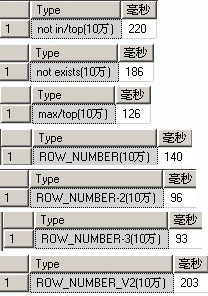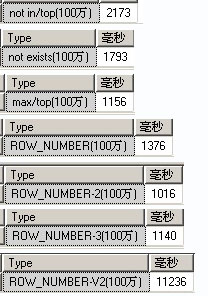分頁很重要,面試會遇到。不妨再回顧總結一下。
1、創建測試環境,(插入100萬條數據大概耗時5分鐘)。
createdatabaseDBTest
useDBTest
--創建測試表
createtablepagetest
(
idintidentity(1,1)notnull,
col01intnull,
col02nvarchar(50)null,
col03datetimenull
)
--1萬記錄集
declare@iint
set@i=0
while(@i<10000)
begin
insertintopagetestselectcast(floor(rand()*10000)asint),left(newid(),10),getdate()
set@i=@i+1
end |
2、幾種典型的分頁sql,下面例子是每頁50條,198*50=9900,取第199頁數據。
--寫法1,not in/top
selecttop50*frompagetest
whereidnotin(selecttop9900idfrompagetestorderbyid)
orderbyid
--寫法2,not exists
selecttop50*frompagetest
wherenotexists
(select1from(selecttop9900idfrompagetestorderbyid)awherea.id=pagetest.id)
orderbyid
--寫法3,max/top
selecttop50*frompagetest
whereid>(selectmax(id)from(selecttop9900idfrompagetestorderbyid)a)
orderbyid
--寫法4,row_number()
selecttop50*from
(selectrow_number()over(orderbyid)rownumber,*frompagetest)a
whererownumber>9900
select*from
(selectrow_number()over(orderbyid)rownumber,*frompagetest)a
whererownumber>9900andrownumber<9951
select*from
(selectrow_number()over(orderbyid)rownumber,*frompagetest)a
whererownumberbetween9901and9950
--寫法5,在csdn上一帖子看到的,row_number() 變體,不基于已有字段產生記錄序號,先按條件篩選以及排好序,再在結果集上給一常量列用于產生記錄序號
select*
from(
selectrow_number()over(orderbytempColumn)rownumber,*
from(selecttop9950tempColumn=0,*frompagetestwhere1=1orderbyid)a
)b
whererownumber>9900 |
3、分別在1萬,10萬(取1990頁),100(取19900頁)記錄集下測試。
測試sql:
declare @begin_date datetime
declare @end_date datetime
select @begin_date = getdate()
<.....YOUR CODE.....>
select @end_date = getdate()
select datediff(ms,@begin_date,@end_date) as '毫秒' |
1萬:基本感覺不到差異。
10萬:

100萬:

4、結論:
1)max/top,ROW_NUMBER()都是比較不錯的分頁方法。相比ROW_NUMBER()只支持sql2005及以上版本,max/top有更好的可移植性,能同時適用于sql2000,access。
2)not exists感覺是要比not in效率高一點點。
3)ROW_NUMBER()的3種不同寫法效率看起來差不多。
4)ROW_NUMBER() 的變體基于我這個測試效率實在不好。
PS:上面的分頁排序都是基于自增字段id。測試環境還提供了int,nvarchar,datetime類型字段,也可以試試。不過對于非主鍵沒索引的大數據量排序效率應該是很不理想的。
5、簡單將ROWNUMBER,max/top的方式封裝到存儲過程。
ROWNUMBER():
create proc [dbo].[spSqlPageByRownumber]
@tbName varchar(255), --表名
@tbFields varchar(1000), --返回字段
@PageSize int, --頁尺寸
@PageIndex int, --頁碼
@strWhere varchar(1000), --查詢條件
@StrOrder varchar(255), --排序條件
@Total int output --返回總記錄數
as
declare @strSql varchar(5000) --主語句
declare @strSqlCount nvarchar(500)--查詢記錄總數主語句
--------------總記錄數---------------
if @strWhere !=''
begin
set @strSqlCount='Select @TotalCout=count(*) from ' + @tbName + ' where '+ @strWhere
end
else
begin
set @strSqlCount='Select @TotalCout=count(*) from ' + @tbName
end
--------------分頁------------
if @PageIndex <= 0
begin
set @PageIndex = 1
end
set @strSql='Select * from (Select row_number() over('+@strOrder+') rowId,'+ @tbFields
+' from ' + @tbName + ' where 1=1 ' + @strWhere+' ) tb where tb.rowId >'+str((@PageIndex-1)*@PageSize)
+' and tb.rowId <= ' +str(@PageIndex*@PageSize)
exec sp_executesql @strSqlCount,N'@TotalCout int output',@Total output
exec(@strSql) |
Max/top:(簡單寫了下,需要滿足主鍵字段名稱就是"id")
create proc [dbo].[spSqlPageByMaxTop]
@tbName varchar(255), --表名
@tbFields varchar(1000), --返回字段
@PageSize int, --頁尺寸
@PageIndex int, --頁碼
@strWhere varchar(1000), --查詢條件
@StrOrder varchar(255), --排序條件
@Total int output --返回總記錄數
as
declare @strSql varchar(5000) --主語句
declare @strSqlCount nvarchar(500)--查詢記錄總數主語句
--------------總記錄數---------------
if @strWhere !=''
begin
set @strSqlCount='Select @TotalCout=count(*) from ' + @tbName + ' where '+ @strWhere
end
else
begin
set @strSqlCount='Select @TotalCout=count(*) from ' + @tbName
end
--------------分頁------------
if @PageIndex <= 0
begin
set @PageIndex = 1
end
set @strSql='select top '+str(@PageSize)+' * from ' + @tbName + '
where id>(select max(id) from (select top '+str((@PageIndex-1)*@PageSize)+' id from ' + @tbName + ''+@strOrder+')a)
'+@strOrder+''
exec sp_executesql @strSqlCount,N'@TotalCout int output',@Total output
exec(@strSql) |
調用:
declare @count int
--exec [dbo].[spSqlPageByRownumber]'pagetest','*',50,20,'','order by id asc',@count output
exec [dbo].[spSqlPageByMaxTop]'pagetest','*',50,20,'','order by id asc',@count output
select @count |




